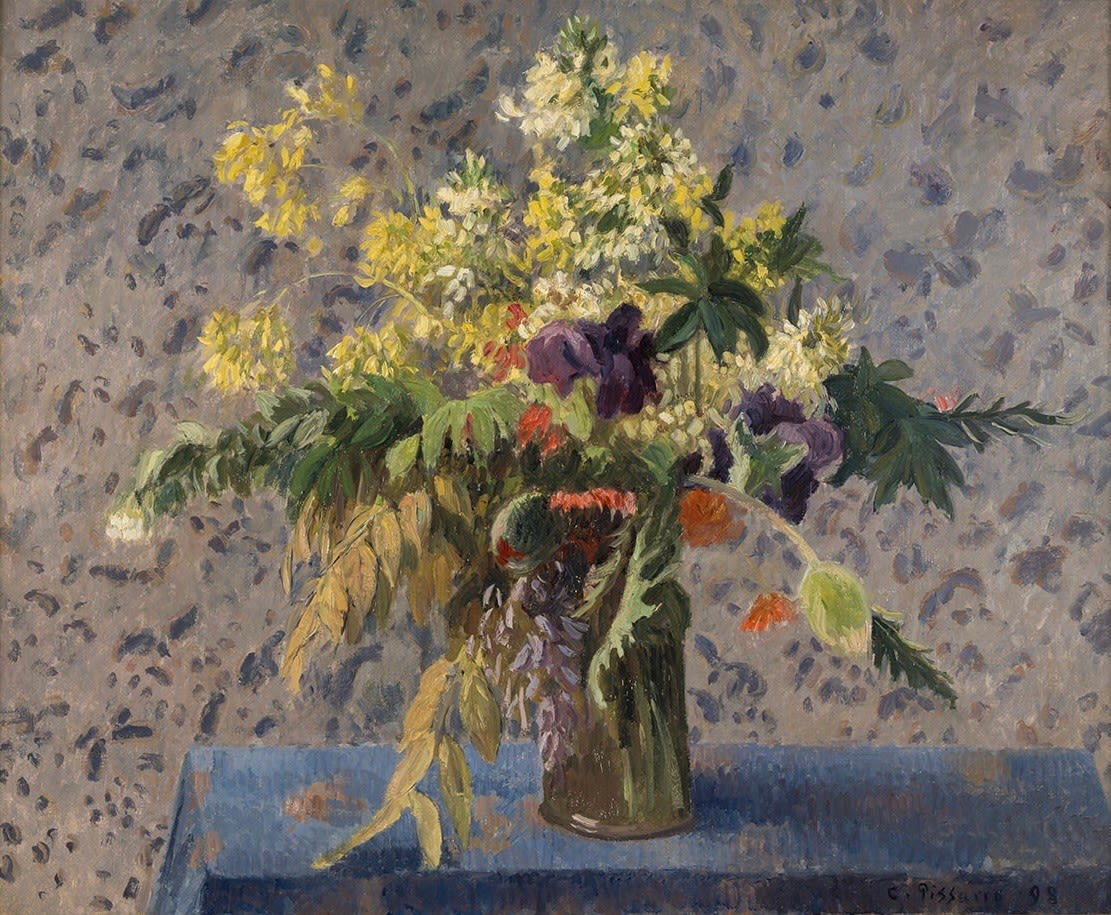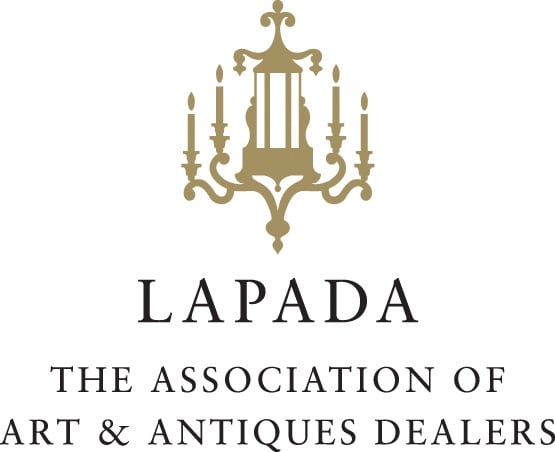Camille Pissarro 1830-1903
Framed: 83 x 96cm.; 32½ x 37¾ in.
In the autumn of 1898, as the nineteenth century approached its conclusion, Camille Pissarro sought refuge in the tranquillity of his studio to capture something profoundly personal yet universally resonant. His Bouquet de Fleurs, Iris, Coquelicots, et Fleurs de Choux emerges not merely as a still life, but as a meditation on transience, domesticity, and the revolutionary potential inherent in the seemingly mundane. The subject represents a masterful synthesis of Impressionist technique and Post-Impressionist sensibility, revealing Pissarro at his most contemplative and technically accomplished.
The composition showcases an asymmetrical arrangement that defies classical conventions while maintaining perfect visual balance. A forest-green vessel anchors the arrangement against an ambiguous, mottled grey-blue ground. Golden mimosa cascade in delicate sprays, juxtaposed with deep purple iris petals. Scarlet poppies punctuate the arrangement, while ornamental cabbage leaves introduce an element of domesticity.
Pissarro's brushwork reveals the full development of his technical vocabulary. The background, a symphony of grey-blue tonalities, showcases his mastery of the broken colour technique. This technique involves applying individual strokes of paint in such a way that they remain visible yet merge into atmospheric unity. The result is a sense of vibration and movement that extends beyond the central motif, suggesting that the very air around the flowers participates in their chromatic dialogue. The artist employs a varied palette knife and brush technique, using broad, confident strokes to define the vase's form, while delicate touches depict the gossamer quality of the mimosa blossoms.
Created during Pissarro's final decade, it demonstrates the continued vitality of his artistic investigation and his evolution from the pure plein-air approach of early Impressionism to a more synthetic vision that incorporates elements of Neo-Impressionist colour theory, and why he remained such a mentoring figure to a whole generation of younger artists. The work exemplifies the quiet authority that made Pissarro such an influential figure.
Unlike Monet, Renoir, Cézanne, and other artists in his circle, Pissarro painted few still lifes, most of which were produced late in his career, making this 1898 canvas particularly significant within his oeuvre. While Cézanne was simultaneously revolutionising the genre through geometric analysis and Chardin-esque gravitas, and Van Gogh was investing similar subjects with psychological intensity, Pissarro approached still life with characteristic restraint and observational honesty. As Richard Brettell has noted, Pissarro's mature work "can be justifiably seen as the single most important manifestation of Pissarro's interests during the classic period, and this principle extends to his rare forays into floral still life. His flowers neither aspire to symbolic meaning nor psychological expression; instead, they assert their presence through pure visual sensation, their beauty residing in the artist's ability to translate optical experience into pigment and gesture.”
What renders the painting so compelling is its embodiment of contradictions that define Pissarro's mature style—contradictions that recent scholarship has identified as central to his lasting influence. The painting simultaneously celebrates spontaneity and demonstrates careful consideration; it appears effortless while showcasing consummate technical skill. Its emphasis on surface pattern, its sophisticated colour relationships, and its spatial ambiguities anticipate developments that would flourish in the work of the Fauves and early modernists.
Bouquet de Fleurs’ enduring presence lies in its ability to transform the most ordinary of subjects – cut flowers in a domestic setting – into a profound statement about the nature of seeing and the possibilities of paint. It offers a vision of art’s capacity to find significance in the seemingly insignificant, beauty in the commonplace, and permanence in the transient.
Provenance
Mme. Julie Pissarro (the artist's widow), Paris
M. Knoedler & Co., New York
Henry Ittelson, Jr., New York
Edward Speelman, London, 1959
Mrs. Neville Blond, O.B.E.
Christie's, London, 23 June 1986, lot 5
Private Collection (purchased from the above)
Exhibitions
Paris, Galerie Nunes et Fiquet, Collection de Madame Yve. Pissarro, May-June 1921, no. 35
Paris, Galerie Charpentier, Les Fleurs et les Fruits depuis le Romanticism, 1942-43, no. 123
Paris, Galerie Charpentier, Tableaux de la Vie silencieuse, 1946, no. 52
New York, Wildenstein & Co., Magic of Flower Painting, April-May 1954, no. 51
London, Marlborough Fine Art, Pissarro in England (a loan exhibition in aid of The Save the Children Fund), June-July 1968, no. 20 (illustrated p. 50)
Literature
L.R. Pissarro and L. Venturi, Camille Pissarro, son art, son oeuvre, Paris, 1938, p. 229, no. 1063 (illustrated)
Joachim Pissarro, Camille Pissarro, London, Pavillion Books Ltd., 1993, p. 271, no. 319 (illustrated)




